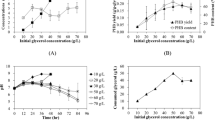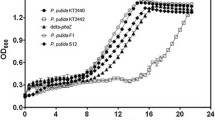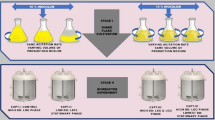Abstract
Acidiphilium cryptum is an acidophilic, heterotrophic, and metallotolerant bacteria able to use dissolved oxygen or Fe(III) as an electron sink. The ability of this extremophile to accumulate poly(3-hydroxybutyrate) (PHB) and secrete extracellular polymeric substances (EPS) has also been reported. Hence, the aim of this work is to characterize the production of PHB and EPS by the wild strain DSM2389 using glycerol in shaken flasks and bioreactor. Results showed that maximum PHB accumulation (37–42% w/w) was obtained using glycerol concentrations of 9 and 15 g L−1, where maximum dry cell weight titers reached 3.6 and 3.9 g L−1, respectively. The culture in the bioreactor showed that PHB accumulation takes place under oxygen limitation, while the redox potential of the culture medium could be used for online monitoring of the PHB production. Recovered EPS was analyzed by Fourier-transform infrared spectroscopy and subjected to gas chromatography—mass spectrometry after cleavage and derivatization steps. These analyses showed the presence of sugars which were identified as mannose, rhamnose and glucose, in a proportion near to 3.2:2.3:1, respectively. Since glycerol had not been used in previous works, these findings suggest the potential of A. cryptum to produce biopolymers from this compound at a large scale with a low risk of microbial contamination due to the low pH of the fermentation process.





Similar content being viewed by others
Data availability
All data generated or analyzed during this study are included in this published article and the supplementary information file.
Abbreviations
- BDM:
-
Basal defined medium
- BEM:
-
Basal E medium
- BSTFA:
-
N,O-bis(trimethylsilyl)trifluoroacetamide
- DTGS:
-
Deuterated triglycine sulfate
- DSMZ:
-
German Collection of Microorganisms and Cell Cultures
- EPS:
-
Extracellular polymeric substances
- FTIR:
-
Fourier-transform infrared spectroscopy
- GC:
-
Gas chromatography
- GMP:
-
Good manufacturing practice
- HPLC:
-
High-performance liquid chromatography
- MEM:
-
Minimum essential medium
- MS:
-
Mass spectrometry
- OD600 :
-
Optical density at 600 nm
- pE:
-
Negative logarithm of the electron activity
- PHA:
-
Polyhydroxyalkanoate
- PHB:
-
Poly(3-hydroxybutyrate)
- RI:
-
Refractive index
- rpm:
-
Revolutions per minute
- TIC:
-
Total ion current
- TMCS:
-
Trimethylchlorosilane
- TMS:
-
Trimethylsilylation
- UDP:
-
Uridine diphosphate
- UV–Vis:
-
Ultraviolet–visible
- vvm:
-
Volume of gas (under standard conditions) per volume of liquid per minute
- v/v:
-
Volume by volume
- w/w:
-
Weight by weight
References
Antranikian G, Streit WR (2022) Microorganisms harbor keys to a circular bioeconomy making them useful tools in fighting plastic pollution and rising CO2 levels. Extremophiles 26:10. https://doi.org/10.1007/s00792-022-01261-4
Batt CA (2014) Alcaligenes. In: Batt CA, Tortorello ML (eds) Encyclopedia of food microbiology, 2nd edn. Academic Press, Oxford, pp 38–41
Beeler E, Singh OV (2016) Extremophiles as sources of inorganic bio-nanoparticles. World J Microbiol Biotechnol 32:156. https://doi.org/10.1007/s11274-016-2111-7
Bhattacharyya S, Chakrabarty BK, Das A, Kundu PN, Banerjee PC (1991) Acidiphilium symbioticum sp.nov., an acidophilic heterotrophic bacterium from Thiobacillus ferrooxidans cultures isolated from Indian mines. Can J Microbiol 37:78–85. https://doi.org/10.1139/m91-012
Bird LJ, Bonnefoy V, Newman DK (2011) Bioenergetic challenges of microbial iron metabolisms. Trends Microbiol 19:330–340. https://doi.org/10.1016/j.tim.2011.05.001
Bonan CIDG, Biazi LE, Dionísio SR, Soares LB, Tramontina R, Sousa AS, de Oliveira Filho CA, Costa AC, Ienczak JL (2020) Redox potential as a key parameter for monitoring and optimization of xylose fermentation with yeast Spathaspora passalidarum under limited-oxygen conditions. Bioprocess Biosyst Eng 43:1509–1519. https://doi.org/10.1007/s00449-020-02344-2
Bryan BA, Linhardt RJ, Daniels L (1986) Variation in composition and yield of exopolysaccharides produced by Klebsiella sp. strain K32 and Acinetobacter calcoaceticus BD4. Appl Environ Microbiol 51:1304–1308. https://doi.org/10.1128/aem.51.6.1304-1308.1986
Carvalho AL, Oliveira FH, Mariano RR, Gouveia ER, Souto-Maior AM (2010) Growth, sporulation and production of bioactive compounds by Bacillus subtilis R14. Braz Arch Biol Technol 53:643–652. https://doi.org/10.1590/S1516-89132010000300020
Chen G-Q, Jiang X-R (2018) Next generation industrial biotechnology based on extremophilic bacteria. Curr Opin Biotechnol 50:94–100. https://doi.org/10.1016/j.copbio.2017.11.016
Chettri D, Verma AK, Sarkar L, Verma AK (2021) Role of extremophiles and their extremozymes in biorefinery process of lignocellulose degradation. Extremophiles 25:203–219. https://doi.org/10.1007/s00792-021-01225-0
Coker J (2016) Extremophiles and biotechnology current uses and prospects. F1000Research. https://doi.org/10.12688/f1000research.7432.1
Costa OYA, Raaijmakers JM, Kuramae EE (2018) Microbial extracellular polymeric substances: ecological function and impact on soil aggregation. Front Microbiol. https://doi.org/10.3389/fmicb.2018.01636
Cummings DE, Fendorf S, Singh N, Sani RK, Peyton BM, Magnuson TS (2006) Reduction of Cr(VI) under acidic conditions by the facultative Fe(III)-reducing bacterium Acidiphilium cryptum. Environ Sci Technol 41:146–152. https://doi.org/10.1021/es061333k
Díaz-Barrera AROM, Andler R, Martínez I, Peña C (2016) Poly-3-hydroxybutyrate production by Azotobacter vinelandii strains in batch cultures at different oxygen transfer rates. J Chem Technol Biotechnol 91(1063):1071. https://doi.org/10.1002/jctb.4684
Díaz-Barrera A, Urtuvia V, Padilla-Córdova C, Peña C (2019) Poly(3-hydroxybutyrate) accumulation by Azotobacter vinelandii under different oxygen transfer strategies. J Ind Microbiol Biotechnol 46:13–19. https://doi.org/10.1007/s10295-018-2090-9
Fett WF, Osman SF, Dunn MF (1989) Characterization of exopolysaccharides produced by plant-associated fluorescent Pseudomonads. Appl Environ Microbiol 55:579–583. https://doi.org/10.1128/aem.55.3.579-583.1989
Fischer J, Quentmeier A, Gansel S, Sabados V, Friedrich C (2002) Inducible aluminum resistance of Acidiphilium cryptum and aluminum tolerance of other acidophilic bacteria. Arch Microbiol 178:554–558. https://doi.org/10.1007/s00203-002-0482-7
González E, Espada A, Muñoz JÁ, Blázquez ML, González F, Ballester A (2015) Reductive dissolution of magnetite and jarosite by Acidiphilium cryptum JF-5. Hydrometallurgy 157:292–297. https://doi.org/10.1016/j.hydromet.2015.08.003
González E, Rodríguez JM, Muñoz JÁ, Blázquez ML, Ballester A, González F (2018) The contribution of Acidiphilium cryptum to the dissolution of low-grade manganese ores. Hydrometallurgy 175:312–318. https://doi.org/10.1016/j.hydromet.2017.12.008
Guo J, Wu Y, Tanaka T, Lin Y-H (2021) Development of redox potential-driven fermentation process for recombinant protein expression. Biotechnol Lett 43:99–103. https://doi.org/10.1007/s10529-020-03030-9
Harrison AP (1981) Acidiphilium cryptum gen. nov., sp. nov., heterotrophic bacterium from acidic mineral environments. Int J Syst Bacteriol 31:327–332. https://doi.org/10.1099/00207713-31-3-327
Henderson RA, Jones CW (1997) Physiology of poly-3-hydroxybutyrate (PHB) production by Alcaligenes eutrophus growing in continuous culture. Microbiology 143:2361–2371. https://doi.org/10.1099/00221287-143-7-2361
Karr DB, Waters JK, Emerich DW (1983) Analysis of Poly-b-Hydroxybutyrate in Rhizobium japonicum bacteroids by ion-exclusion high-pressure liquid chromatography and UV detection. Appl Environ Microbiol 46:1339–1344. https://doi.org/10.1128/aem.46.6.1339-1344.1983
Kavita K, Mishra A, Jha B (2011) Isolation and physico-chemical characterisation of extracellular polymeric substances produced by the marine bacterium Vibrio parahaemolyticus. Biofouling 27:309–317. https://doi.org/10.1080/08927014.2011.562605
Kishimoto N, Inagaki K, Sugio T, Tano T (1990) Growth inhibition of Acidiphilium species by organic acids contained in yeast extract. J Ferment Bioeng 70:7–10. https://doi.org/10.1016/0922-338X(90)90021-N
Koller M (2017) Production of poly hydroxyalkanoate (PHA) biopolyesters by extremophiles? MOJ Poly Sci 1:69–85. https://doi.org/10.15406/mojps.2017.01.00011
Küsel K, Dorsch T, Acker G, Stackebrandt E (1999) Microbial reduction of Fe(III) in acidic sediments: isolation of Acidiphilium cryptum JF-5 capable of coupling the reduction of Fe(III) to the oxidation of glucose. Appl Environ Microbiol 65:3633–3640. https://doi.org/10.1128/AEM.65.8.3633-3640.1999
Li L, Liu Z, Zhang M, Meng D, Liu X, Wang P, Li X, Jiang Z, Zhong S, Jiang C, Yin H (2020) Insights into the Metabolism and Evolution of the genus Acidiphilium, a typical acidophile in acid mine drainage. mSystems 5:e00867-e920. https://doi.org/10.1128/mSystems.00867-20
Link H, Weuster-Botz D (2011) 2.11 - Medium formulation and development. In: Moo-Young M (ed) Comprehensive biotechnology (Second Edition). Academic Press, Burlington, pp 119–134
Liu C-G, Xue C, Lin Y-H, Bai F-W (2013) Redox potential control and applications in microaerobic and anaerobic fermentations. Biotechnol Adv 31:257–265. https://doi.org/10.1016/j.biotechadv.2012.11.005
Liu C-G, Qin J-C, Lin Y-H (2017) Fermentation and redox potential. In: Jozala A (ed) Fermentation Processes. IntechOpen, Londan
Luef KP, Stelzer F, Wiesbrockb F (2015) Poly(hydroxy alkanoate)s in medical applications. Chem Biochem Eng Q 29:287–297. https://doi.org/10.15255/CABEQ.2014.2261
Monteiro MR, Kugelmeier CL, Pinheiro RS, Batalha MO, da Silva CA (2018) Glycerol from biodiesel production: Technological paths for sustainability. Renew Sustain Energy Rev 88:109–122. https://doi.org/10.1016/j.rser.2018.02.019
Naranjo JM, Posada JA, Higuita JC, Cardona CA (2013) Valorization of glycerol through the production of biopolymers: The PHB case using Bacillus megaterium. Bioresour Technol 133:38–44. https://doi.org/10.1016/j.biortech.2013.01.129
Notararigo S, Nácher-Vázquez M, Ibarburu I, Werning ML, de Palencia PF, Dueñas MT, Aznar R, López P, Prieto A (2013) Comparative analysis of production and purification of homo- and hetero-polysaccharides produced by lactic acid bacteria. Carbohydr Polym 93:57–64. https://doi.org/10.1016/j.carbpol.2012.05.016
Palmeiro-Sánchez T, O’Flaherty V, Lens PNL (2022) Polyhydroxyalkanoate bio-production and its rise as biomaterial of the future. J Biotechnol 348:10–25. https://doi.org/10.1016/j.jbiotec.2022.03.001
Posch AE, Spadiut O, Herwig C (2012) Switching industrial production processes from complex to defined media: method development and case study using the example of Penicillium chrysogenum. Microb Cell Fact 11:88. https://doi.org/10.1186/1475-2859-11-88
Roca C, Alves VD, Freitas F, Reis MAM (2015) Exopolysaccharides enriched in rare sugars: bacterial sources, production, and applications. Front Microbiol. https://doi.org/10.3389/fmicb.2015.00288
Scott F, Yañez L, Conejeros R, Araya B, Vergara-Fernández A (2021) Two internal bottlenecks cause the overflow metabolism leading to poly(3-hydroxybutyrate) production in Azohydromonas lata DSM1123. J Environ Chem Eng 9:105665. https://doi.org/10.1016/j.jece.2021.105665
Sharma A, Parashar D, Satyanarayana T (2016) Acidophilic Microbes: Biology and Applications. In: Rampelotto PH (ed) Biotechnology of extremophiles: advances and challenges. Springer International Publishing, Cham, pp 215–241
Shi Y, Huang J, Zeng G, Gu Y, Chen Y, Hu Y, Tang B, Zhou J, Yang Y, Shi L (2017) Exploiting extracellular polymeric substances (EPS) controlling strategies for performance enhancement of biological wastewater treatments: an overview. Chemosphere 180:396–411. https://doi.org/10.1016/j.chemosphere.2017.04.042
Sirohi R, Prakash Pandey J, Kumar Gaur V, Gnansounou E, Sindhu R (2020) Critical overview of biomass feedstocks as sustainable substrates for the production of polyhydroxybutyrate (PHB). Bioresour Technol 311:123536. https://doi.org/10.1016/j.biortech.2020.123536
Sriyapai T, Chuarung T, Kimbara K, Samosorn S, Sriyapai P (2022) Production and optimization of polyhydroxyalkanoates (PHAs) from Paraburkholderia sp. PFN 29 under submerged fermentation. Electron J Biotechnol 56:1–11. https://doi.org/10.1016/j.ejbt.2021.12.003
Tapia JM, Muñoz JA, González F, Blázquez ML, Malki M, Ballester A (2009) Extraction of extracellular polymeric substances from the acidophilic bacterium Acidiphilium 3.2Sup(5). Water Sci Technol 59:1959–1967. https://doi.org/10.2166/wst.2009.192
Tapia JM, Muñoz JA, González F, Blázquez ML, Ballester A (2011) Mechanism of adsorption of ferric iron by extracellular polymeric substances (EPS) from a bacterium Acidiphilium sp. Water Sci Technol 64:1716–1722. https://doi.org/10.2166/wst.2011.649
Tapia JM, Muñoz J, González F, Blázquez ML, Ballester A (2016) Sorption of ferrous iron by EPS from the acidophilic bacterium Acidiphilium Sp a mechanism proposal. Rev Metal 52:e076. https://doi.org/10.3989/revmetalm.076
Tourney J, Ngwenya BT (2014) The role of bacterial extracellular polymeric substances in geomicrobiology. Chem Geol 386:115–132. https://doi.org/10.1016/j.chemgeo.2014.08.011
Verma M, Singh V, Mishra V (2023) Moving towards the enhancement of extracellular electron transfer in electrogens. World J Microbiol Biotechnol 39:130. https://doi.org/10.1007/s11274-023-03582-8
Vinoth S, Gurusaravanan P, Arun M, Saradhadevi M, Senthilkumar N, Gowtham P, Sivakumar SR (2021) Biostimulant activity of sulfated polysaccharide extract from red seaweed Halymenia dilatata on yield of Mung bean in greenhouse conditions. J Appl Phycol 33:3309–3317. https://doi.org/10.1007/s10811-021-02507-y
Wang Q, Fang Y (2004) Analysis of sugars in traditional Chinese drugs. J Chromatogr B 812:309–324. https://doi.org/10.1016/j.jchromb.2004.09.027
Wen Q, Liu B, Li F, Chen Z (2020) Substrate strategy optimization for polyhydroxyalkanoates producing culture enrichment from crude glycerol. Bioresour Technol 311:123516. https://doi.org/10.1016/j.biortech.2020.123516
Xu A-L, Xia J, Liu K, Li L, Yang Y, Nie Z, Qiu G (2010) Real-time PCR Analysis of metabolic pathway of PHB in Acidiphilium cryptum DX1–1. J Microbiol Biotechnol. https://doi.org/10.4014/jmb.0906.06054
Xu A-l, Xia J-l, Song Z-w, Jiang P, Xia Y, Wan M-x, Zhang R-y, Yang Y, Liu K-k (2013) The effect of energy substrates on PHB accumulation of Acidiphilium cryptum DX1-1. Curr Microbiol 67:379–387. https://doi.org/10.1007/s00284-013-0373-y
Zhang J, Greasham R (1999) Chemically defined media for commercial fermentations. Appl Microbiol Biotechnol 51:407–421. https://doi.org/10.1007/s002530051411
Funding
This study was funded by the National Agency for Research and Development (ANID), Chile, grants Fondecyt Iniciación 11180688 and Fondecyt Regular 1211434.
Author information
Authors and Affiliations
Contributions
EG, AD conceived and designed research. CZ, GZ, NM performed microbial cultures in shaken flasks and bioreactor. JPS performed EPS analysis by FTIR. MVR and AR performed the identification and quantification of glycosyl residues. EG, MVR and BP analyzed data. EG, FS and AD wrote the manuscript. All authors reviewed the manuscript.
Corresponding author
Ethics declarations
Conflict of interest
The authors have no relevant financial or non-financial interests to disclose.
Ethical approval
This article does not contain any studies with human participants or animals performed by any of the authors.
Additional information
Communicated by Atomi.
Publisher's Note
Springer Nature remains neutral with regard to jurisdictional claims in published maps and institutional affiliations.
Supplementary Information
Below is the link to the electronic supplementary material.
Rights and permissions
Springer Nature or its licensor (e.g. a society or other partner) holds exclusive rights to this article under a publishing agreement with the author(s) or other rightsholder(s); author self-archiving of the accepted manuscript version of this article is solely governed by the terms of such publishing agreement and applicable law.
About this article
Cite this article
González, E., Zuleta, C., Zamora, G. et al. Production of poly (3-hydroxybutyrate) and extracellular polymeric substances from glycerol by the acidophile Acidiphilium cryptum. Extremophiles 27, 30 (2023). https://doi.org/10.1007/s00792-023-01313-3
Received:
Accepted:
Published:
DOI: https://doi.org/10.1007/s00792-023-01313-3




